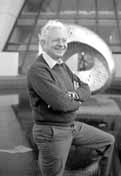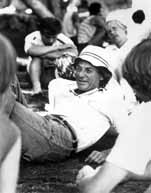 |
|
Nobel '99 A Strong Vote for Electroweak Theory
"To me, nature is a big jigsaw puzzle, and I see it as my task to try to fit pieces of it together."--Web home page of Professor Gerardus 'T Hooft, University of Utrecht, Netherlands
by Mike Perricone In the early 1970s, Chris Quigg was a young physicist at the State University of New York at Stony Brook, on Long Island. He met another young physicist from the Netherlands, named Gerardus 't Hooft, at a reception for new Ph.D.'s in the home of a Stony Brook professor. "A card table had been set up with pieces of a jigsaw puzzle scattered over it, and people would come over to put in usually a corner piece or an edge piece," Quigg recalled. "'t Hooft picked up a random piece, not an edge or a corner, but something from the middle. He stared at it intently. Then he put it down on the table, with great confidence, exactly where it should go. At the least, it was a good act. I decided from that moment, that here was a guy with very impressive geometrical insight." Quigg's intuition was accurate. 't Hooft was already immersed in the work that was to win the 1999 Nobel Prize in Physics for himself and for his teacher, Martinus Veltman, cited by the Royal Swedish Academy of Sciences "for elucidating the quantum structure of electroweak interactions in physics." The Academy credited 't Hooft, 53, and Veltman, 68, for placing particle physics theory on a firmer mathematical foundation, for giving researchers a well-functioning "theoretical machinery" which, among other applications, can be used for predicting the properties of new particles. Those new particles may include the Higgs boson, predicted as the source of mass: the next big prize in particle physics, perhaps the key to a future Nobel Prize. Quigg, a Fermilab theorist, explained that evidence is growing within electroweak theory for a relatively light Higgs mass. A light mass makes it possible for the particle to be discovered in experiments of the Large Electron Positron Collider at CERN, the European particle physics laboratory in Switzerland; or quite possibly at Fermilab in what is called "Extended Run II" of the Tevatron, scheduled to begin in 2001. "That kind of inference comes from the style of calculations that Veltman pioneered, using tools that [Veltman and 't Hooft] developed together," Quigg said. "With this very practical application, we have guidance for our experiments on where the Higgs mass should be. That clearly has an effect on the everyday lives of particle physicists, if not of people on the street."
A step toward unity
By the 1930s, physicists were attempting to unify quantum mechanics with electromagnetism into a quantum field theory. The result—quantum electrodynamics—was made possible in the 1940s by the work of Sin-Itiro Tomonaga, Julian Schwinger and Richard Feynman. These three (who shared the 1965 Nobel Prize) realized they could back off and view individual particles at a distance to solve the difficulties posed by quantum mechanics (including the existence of short-lived virtual particles). But uniting electromagnetism with the weak force was tougher. Mathematical operations in quantum electrodynamics could be performed in any order (like addition and multiplication, or moving an object in two-dimensional space). Sheldon Glashow, Abdus Salam and Steven Weinberg shared the 1979 Nobel Prize for formulating a theory of electroweak interaction using operations that depended on their order (like division and subtraction, or moving an object in three-dimensional space). Their theory predicted the new W and Z force-carrier particles, which were detected at CERN in 1983 and immediately won the 1984 Nobel Prize for Carlo Rubbia and Simon van der Meer.
Enter Veltman
Field theories are gauge theories, where individual particles are representations of a group. Individual particles react to an operation the way the group reacts. Another of Feynman's contributions was the Feynman diagram, providing a system for calculations in gauge theories. Veltman took theory and calculations to the next level. "From some time in the 1960s, Veltman was one of the people very interested in developing techniques to calculate reliably with gauge theory," said Quigg, the author of a noted book on gauge theories. "[To him], the job of a theoretical physicist is to be able to evaluate the Feynman diagrams, and then draw the experimental consequences of the theory." Veltman, originally of the University of Utrecht and now John D. MacArthur Professor of Physics at the University of Michigan, has a long association with Fermilab. He was a member of the Lab's Physics Advisory Committee while Leon Lederman (1988 Nobel Prize) served as director, and he was a frequent visitor to the Lab's Theoretical Physics Department. Quigg remembers Veltman as being "very stimulating" on the PAC, because "his opinions were completely unedited." While at Utrecht, Veltman developed one of the early computer-based algebra programs to facilitate calculations in Feynman diagrams. The program was called Schoonschip, or "beautiful ship" ("It's probably something more blasphemous in Dutch," Quigg quipped). Together with 't Hooft, his student in the 1960s, Veltman developed new methods for isolating and dealing with the infinities that crop up in the middle of the calculations. Meanwhile, 't Hooft combined Veltman's teaching with ideas of the late Ben Lee, early head of Theory at Fermilab. He demonstrated that gauge theories like electroweak theory could be used to calculate reliable predictions extending to the high-energy realm. 't Hooft, Quigg said, was also the first to calculate the electroweak theory consequences of such simple reactions as a neutrino scattering from an electron. Discoveries at CERN in 1973 bore out 't Hooft's predictions, demonstrating the existence of neutral currents and showing that electroweak theory was to be taken seriously. Then Veltman applied electroweak theory to neutral currents with his new calculation methods, making predictions (since borne out at LEP) relating the mass systems of the W and Z bosons to the square of the top quark mass—showing where the Higgs piece fits in the middle of the puzzle.
Sharing the credit
Quigg described Veltman, nicknamed "Tini," as "a crusty guy," adding: "You sometimes can't tell if he's being very nice or very mean, but you love him anyway." It would have been easy (and not unprecedented in science) for the "crusty" Veltman to claim all these results from his own work, with 't Hooft the student following the teacher's ideas. But Quigg cited a vivid example of Veltman's consistent and early insistence that 't Hooft's work spoke for itself. The event that stood out for Quigg was the Ben Lee memorial conference at Fermilab in 1978. Lee had been killed in a car crash the previous year. "What Veltman did at that conference was really impressive," Quigg recalled. "He was the professor, and he could easily have signed his name to any papers [that were published]. But Veltman specifically cited 't Hooft's accomplishments. So the intellectual rigor he applied to other people, sometimes in a nasty way, he also applied to himself." The Prize:Pro and Con
~Leon Lederman, The God Particle
~Richard Feynman, Surely You're Joking, Mr. Feynman
Waiting is part of the package
The phenomenon of CP Violation won The Prize for James Cronin and Val Fitch, and has moved to the forefront of everyday thinking in particle physics. But both developments came slowly.
"I'm surprised that it's taken this long to get at the answers," said Cronin, who made the discovery with Fitch in 1964. "In fact, it took about 35 years to get to the point of a breakthrough, of learning something brand new."
Cronin and Fitch won The Prize in 1980, sixteen years after their results.
"I'll probably get some brickbats for saying this," he quipped, "but I think the Nobel Committee was remiss in taking so long to recognize the importance of the result, especially with the relevance to cosmology so clearly pointed out by [Andrei] Sakharov in 1967."
Others have waited longer: 28 years for Leon Lederman, Mel Schwartz and Jack Steinberger. But with the delay, Cronin admitted, "by then I was more mature. It's probably better that The Prize didn't come sooner."
Cronin welcomed recent time asymmetry results from KTeV at Fermilab, and NA48 at CERN, and he was enthusiastic about "B factories" being developed specifically to explore CP violation.
"I would say that within the next five to 10 years, we'll make a lot more progress than in the past 35," he said. "It is kind of amazing to have come upon a discovery that has persisted in interest, and has taken so long to unravel. We still don't know what it is."
Now he's working on another mystery as co-leader of the Pierre Auger Observatory, investigating high-energy cosmic rays. At 1020 electron volts, they're the highest energies witnessed in the universe—a million times the energy reached at Fermilab's Tevatron, the world's highest-energy particle accelerator.
"I guess [the shift] is a culmination of the sociology of physics, and of trying to move into something where one feels one can make a difference," Cronin explained. "Physics at CDF, or DZero, or LHC—that's going to happen, whether I participate or not…the attack on the highest energy cosmic rays is a genuine mystery. Nobody knows their origin, but we know nature is creating them. It's different, and it's really exciting."
Cronin remains a close friend of Fitch, who has stayed at Princeton University, but says they don't dwell on their famed experiment.
"It's not our highest priority in conversation," he said. "We follow developments with great interest, but we've both gone on to other things. [CP violation] is in good hands with newer and younger people."
|
| last modified 12/17/1999 email Fermilab |
FRLsDFx9eyfrPXgV
 "The Prize is an incredible ticket to help one effect socially redeeming activities...what I intend to do is to use The Prize shamelessly to help advance science education in the United States. For this task a second Prize would be helpful."
"The Prize is an incredible ticket to help one effect socially redeeming activities...what I intend to do is to use The Prize shamelessly to help advance science education in the United States. For this task a second Prize would be helpful."
 "It's nice that I got some money--I was able to buy a beach house--but altogether, I think it would have been much nicer not to have had The Prize--because you never, any longer, can be taken straightforwardly in any public situation."
"It's nice that I got some money--I was able to buy a beach house--but altogether, I think it would have been much nicer not to have had The Prize--because you never, any longer, can be taken straightforwardly in any public situation."